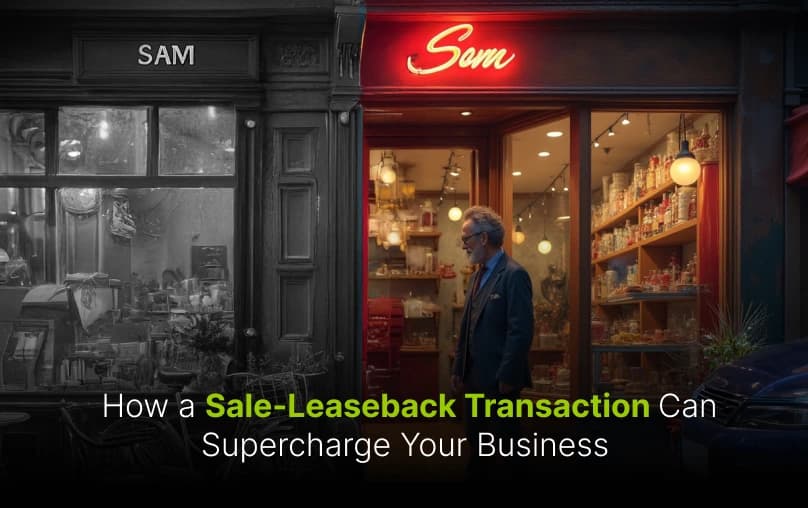
Cash Without Compromise: How a Sale-Leaseback Transaction Can Supercharge Your Business
Published on:
Ever feel like you're asset-rich but cash-poor? Maybe you've got high-value machinery, a bustling facility, or prime real estate, but not enough liquid funds to chase that next big opportunity.
Taking out a loan means piling on debt, and selling off the asset isn’t an option, as you still need it to keep operations humming.
That’s where a sale-leaseback transaction (aka, SLB) comes in like your financial wingman. It’s a savvy move that lets you unlock the value of your assets by selling them for immediate cash, then leasing them back so you can keep using them, without skipping a beat in your business operations.
Here’s how it works, step-by-step:
1. Sell the Asset: You sell your asset (say, a piece of equipment) at fair market value. Boom! You get a lump sum of cash in the bank.
2. Lease It Back: You sign a lease agreement with the buyer to keep using the asset for a set period.
3. Keep Using It: You don’t skip a beat. Your operations continue just like before.
4. End-of-Lease Options: When the lease ends, you can buy the asset back, renew the lease, or return it.
It’s a strategic financial move and a smart one, too.
.gif)
Why Smart Businesses Are Turning to Sale-Leasebacks
Now, let’s break down why businesses, especially in capital-heavy industries like biotech, manufacturing, and tech, jump at this opportunity:
1. Get That Sweet, Sweet Liquidity
You’ve got valuable stuff just sitting on your balance sheet. With sales leaseback, you’re converting those bricks and bolts into usable cash. Use it to invest in R&D, hire talent, or launch your next product line.
2. Boost Your Cash Flow
Rather than a huge upfront investment, you now have manageable lease payments. It’s like shifting from buying a car in cash to taking a low-interest monthly lease, you get flexibility without draining your wallet.
3. Skip the Debt Trap
Unlike loans, SLB doesn’t add debt to your balance sheet. That keeps your credit rating happy and makes you look financially sharp to investors and banks.
4. Maximize Existing Assets
Whether it’s equipment you just bought or something that’s been powering your operations for years, a sale-leaseback lets you tap into its value without giving it up or taking it offline. You keep using what’s already working for your business, just with a smarter financial setup behind it.
5. Tax Perks
Lease payments are usually tax-deductible providing potential savings for your business.
6. No Operational Disruption
This is key. You still run your business without missing a beat. Everything stays the same, except now your bank account looks a whole lot healthier.
Real-World Examples: Who’s Doing It?
Let’s look at how real businesses are using sales leaseback transactions to level up:
Life Time Group Holdings, a wellness and lifestyle company with nearly 160 athletic country clubs across the U.S. and Canada, pulled off a textbook example of how a well-timed sale-leaseback can fuel growth without breaking a sweat.
In 2022, Life Time completed nine sale-leaseback transactions, unlocking $375 million in gross proceeds. The funds were strategically used to pay down debt and support new growth opportunities, all while continuing to operate their clubs without disruption.
What’s more, the company announced plans to potentially monetize another $300 million in real estate by the end of the year, pushing the total value of sale-leasebacks in 2022 to around $675 million. That’s how you turn real estate into rocket fuel for expansion while keeping operations in full swing. - Source
SLB in Action: A Simple Walkthrough
Alright, let’s put on our finance hats for a sec, don’t worry, I’ll keep it simple.
Scenario: ABC Manufacturing owns a factory worth $1,000,000. They need cash to expand.
Instead of borrowing, they sell the factory to Investor XYZ and lease it back for 10 years. XYZ wants a 6% annual return on its $1M investment.
Here’s how we calculate the annual lease payment:
We’ll use the Present Value Annuity Formula, which helps figure out the lease payment that gives the buyer their desired return.
• Sale Price (PV) = $1,000,000
• Annual Return (r) = 6%
• Lease Term (n) = 10 years
• PV Annuity Factor ≈ 7.36 (based on 10 years @ 6%)
Annual Lease Payment = $1,000,000 ÷ 7.36 = ~$135,867
So ABC pays $135,867 per year for 10 years.
At the end of the lease? They could:
• Re-negotiate and stay,
• Buy it back at fair market value, or
• Walk away.
Simple, right? Well… not exactly.
It’s Not Always a Cakewalk…
Here’s the catch. While the concept of a sale-leaseback feels straightforward, the execution can get a little hairy.
• Determining fair market value? That requires expert valuation.
• Structuring the lease to meet accounting standards (like ASC 842)? That's a compliance puzzle.
• Calculating the present value, interest rates, and lease liability? You’ll need some number crunching power.
It’s not just math, it’s strategy, accounting, tax, and legal all rolled into one. And when you’re juggling daily ops, HR issues, and customer delivery deadlines, do you really want to go down this rabbit hole?
Here’s a Better Way: Outsource to the Pros
If all this sounds like a lot, it’s because it is. That’s why smart companies don’t try to handle sales leaseback accounting solo. They partner with a strategic accounting team that knows the ins and outs of:
• Fair valuation
• Lease classification
• Compliance with U.S. GAAP and ASC 842
• Tax implications
At the end of the day, you focus on what you do best, growing your business. Let the pros handle the spreadsheets, tax codes, and compliance chaos.

Shekhar Mehrotra
Founder and Chief Executive Officer
Shekhar Mehrotra, a Chartered Accountant with over 12 years of experience, has been a leader in finance, tax, and accounting. He has advised clients across sectors like infrastructure, IT, and pharmaceuticals, providing expertise in management, direct and indirect taxes, audits, and compliance. As a 360-degree virtual CFO, Shekhar has streamlined accounting processes and managed cash flow to ensure businesses remain tax and regulatory compliant.
You might also like:
- The Accounting Reality Behind Claim Denials That Quietly Drain Clinic Revenue
- 9 Practical Strategies to Improve Cash Flow for Small Businesses
- Qualified Improvement Property (QIP): The Smart Way to Accelerate Depreciation on Commercial Renovations
- Why Smart E-Commerce Owners in the U.S. Are Outsourcing Their Accounting
- The Ultimate Guide to SaaS Accounting: Metrics, Revenue, and Growth Hacks
Listen Exclusive Podcast On

